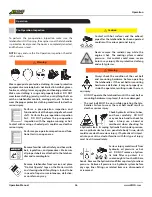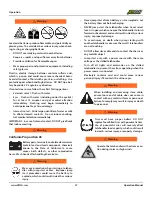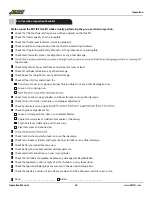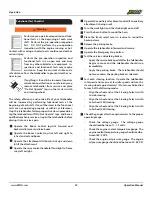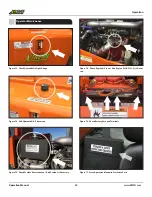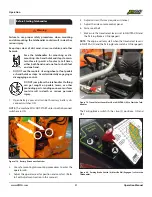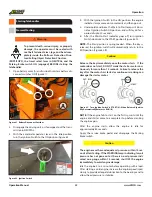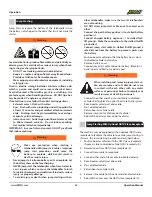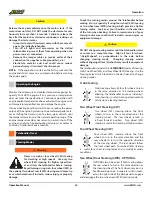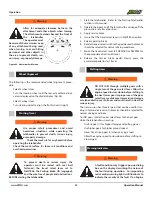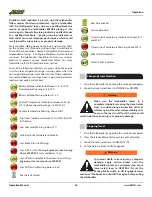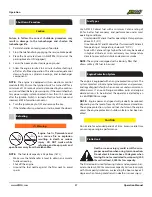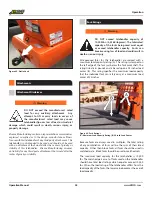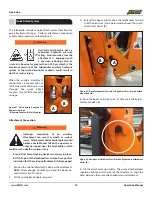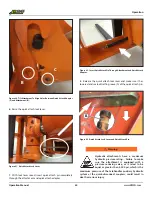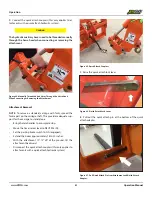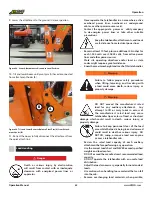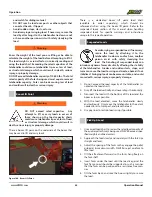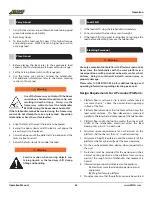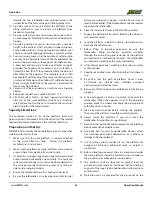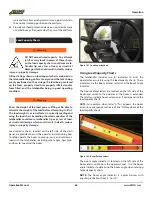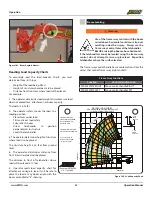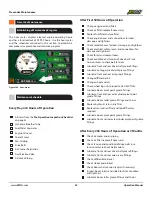
Operation Manual
54
www.XMFG.com
Operation
Check the turning radius around the telehandler before
making a turn, especially if using four wheel (4W) steering
or two wheel rear (2WR) steering, which provide a tighter
turning radius. Look over your shoulder in the direction
of the turn when backing. Failure to remain aware of your
turning radius area could result in death, serious injury, or
equipment damage.
Steering Modes
Telehandler Travel
Warning
Never use crab or four wheel (4W) steering
for traveling at high speeds. Use only two
wheel (2W) steering for higher speed trav-
el and slow the telehandler before turning.
Rapid turning using crab, four wheel (4W), or
the optional two wheel rear (2WR) steering could cause tip
over, which could result in death, serious injury, or property
damage.
DO NOT change steering modes until the telehandler slows
or comes to a complete stop. Align all four (4) wheels
“straight-ahead”, or perpendicular to the axle, before
changing steering mode. Changing steering modes
without aligning all four (4) wheels may result in equipment
damage.
Crab steering allows all four (4) wheels to turn
in the same direction as the steering wheel,
allowing the telehandler to move “sideways”.
Crab steering is useful in a congested work site
to line up to a loading location.
Crab Steering
Two wheel (2W) steering allows the front
wheels to turn in the same direction as the
steering wheel. The rear wheels remain in
a fixed forward position. Two wheel (2W)
steering is useful for traveling at higher speeds.
Two Wheel Front Steering (2W)
Four wheel (4W) steering allows the front
wheels to turn in the same direction and the
rear wheels to turn in the opposite direction
of the steering wheel. The rear wheels follow
the front wheel path. Four wheel (4W) steering
is useful for a short turning radius and in muddy or sandy
conditions.
Four Wheel Steering (4W)
Two Wheel Rear Steering (2WR) - OPTIONAL
OPTIONAL two wheel rear (2WR) steering allows
the rear wheels to turn in the same direction as
the steering wheel. The front wheels remain in a
fixed forward position. A separate switch is locat-
ed on the right side of the dash panel to engage
and disengage the two wheel rear (2WR) steering mode.
The telehandler includes three STANDARD modes of steering;
Crab, Two Wheel (2W), and Four Wheel (4W) Steering. Use the
Steering Select switch located on the dash panel to change
steering modes.
Operating the Engine
Monitor the oil pressure and coolant temperature gauges fre-
quently. Shut off the engine if any pressure or temperature
does not meet the specifications. Continuous operation with
engine coolant temperature above or below the engine cool-
ant temperature specifications can damage the engine.
If an overheating condition starts to occur, reduce the power
output of the engine by releasing the accelerator pedal or le-
ver or shifting the transmission to a lower gear, or both, until
the temperature returns to the normal operating range. If the
engine temperature does not return to normal, shut off the
engine, and refer to Troubleshooting Symptoms, or contact a
Cummins® Authorized Repair Location.
Caution
NOTE: If the engine fails to start on the first try, wait until the
engine and starter come to a complete stop before cranking
the engine again.
Release the key immediately once the motor starts. If the
motor does not start, DO NOT crank the starter motor con-
tinuously for more than 15 seconds. Failure to release the
key after the motor has started or continuous cranking can
damage the starter motor.
•
Jump start only with a power source with the same volt-
age as the stalled telehandler.
•
Turn off all lights and accessories on the stalled
telehandler to prevent them from operating when the
power source is connected.
•
Remove the jumper cables in reverse order of their
connection (i.e. negative cable ground first, etc.)
•
Electrolyte contains acid and could cause serious
personal injury if it contacts the skin or eyes.
Caution







